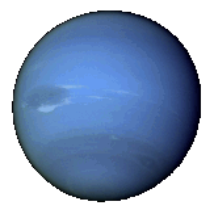Neptune is the other sub-jovian planet, along with Uranus. It presents a number of
differences from either Jupiter or Saturn. It is quite a bit colder and denser. The blue color of
the clouds is due to the presence of methane gas in the atmosphere. We believe there is an
appreciable layer of ice within the interior of the planet. With no layer of metallic hydrogen to
generate a magnetic field, Neptune apparently uses a layer of highly compressed water as the
electrically conducting fluid.
The existence of the eighth planet was revealed to humans in the year 1846. Two men had independently
calculated the supposed planet’s position using its gravitational influence on Uranus. Who discovered
Neptune? Was it John C. Adams or Urbain Leverier? Here’s one version of the story. I guess the answer to
that depends on whether you are French or a loyal British subject. The famous physicist Richard Feynman
gives this amusing twist to the story. Although the first person to see Neptune, and know that it was a planet,
was Johann Galle? Wait, did Galileo discover Neptune?


















































